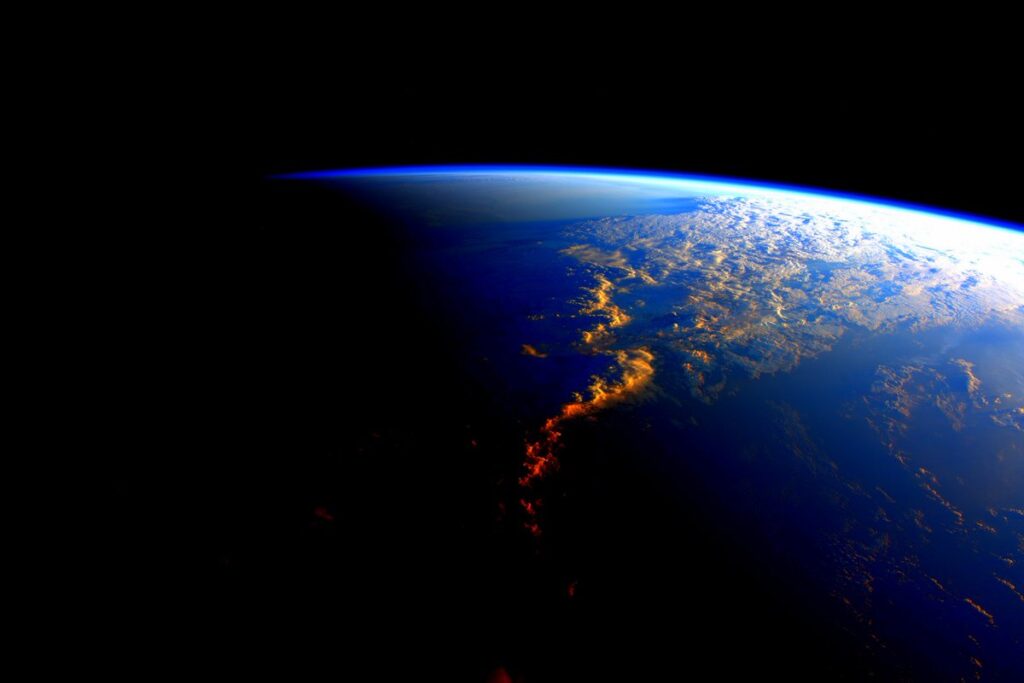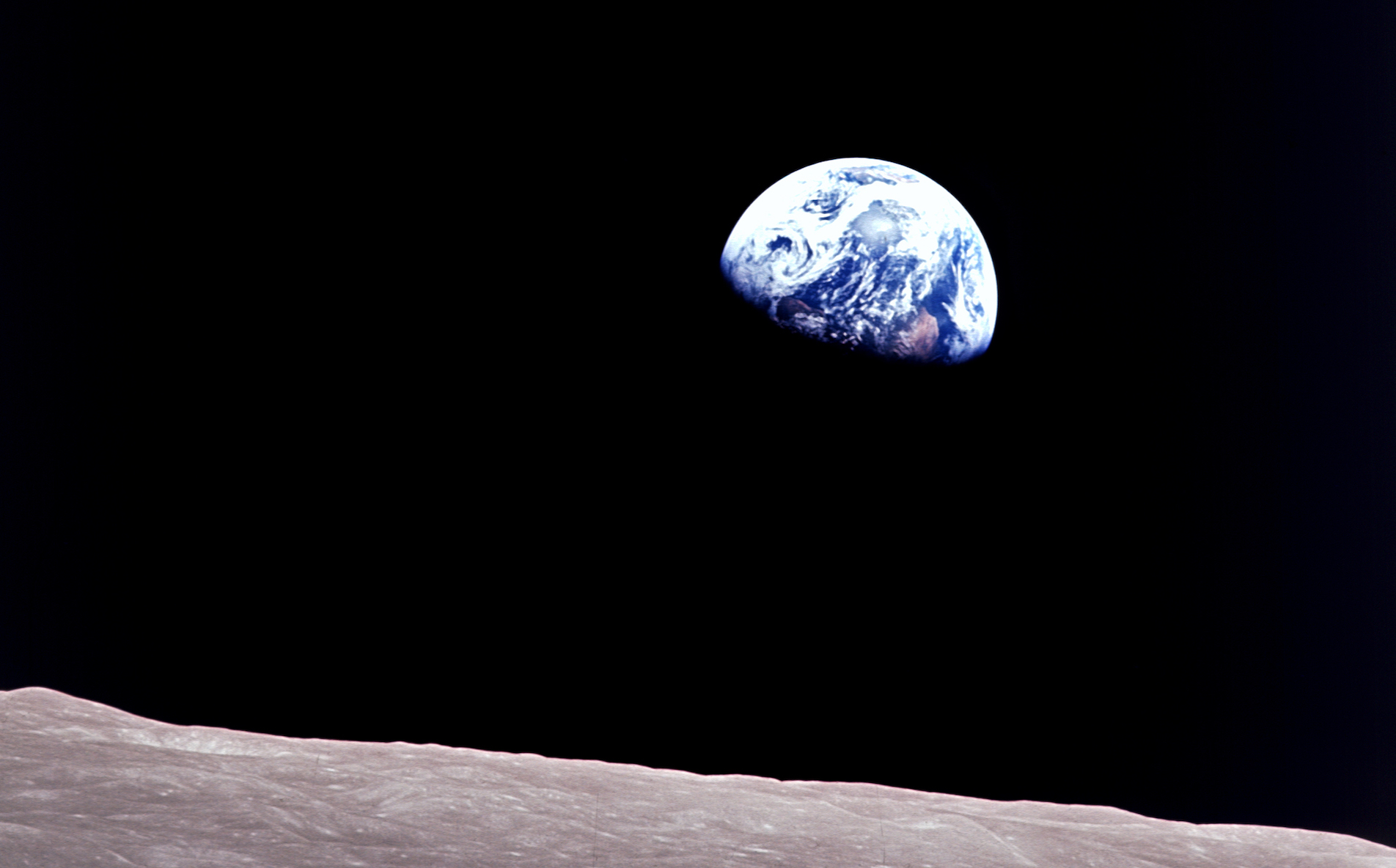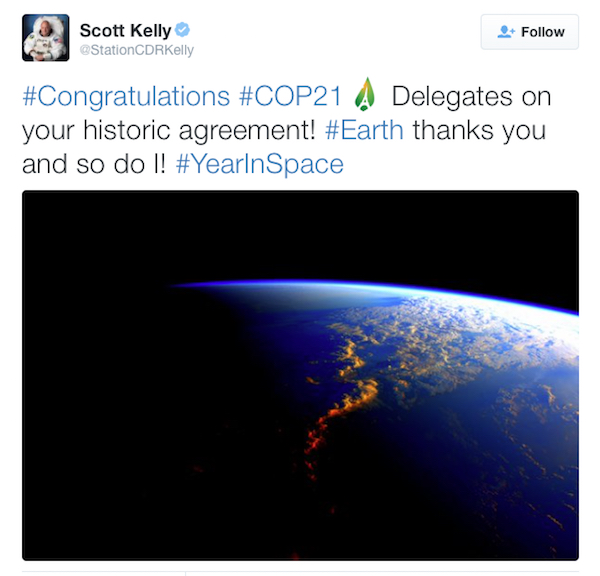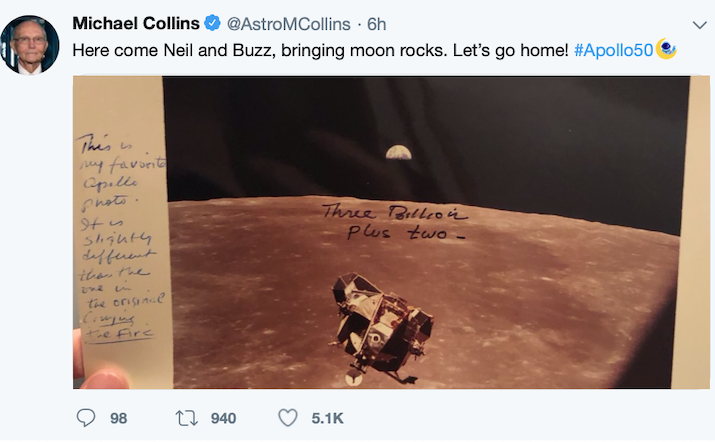
International Space Station Commander Scott Kelly’s celebration of the 2015 Paris Climate Agreement, tweeted from space, included his photo of Earth.
For millennia, humans have turned their attention and thoughts to the skies in late December as the daily period of sunlight grew shorter and shorter, then started getting longer again. In the Northern Hemisphere, ancient peoples of many cultures began observing the Winter Solstice – the shortest day of the year, on or around Dec. 21 – with hopeful celebrations of light and harvest.
On Dec. 21 this year, there was another reason to look skyward. Jupiter and Saturn appeared to be so near to one another that they seemed like a double planet. It was the closest such “conjunction” since 1226.
December has also been a time when American astronauts looked homeward toward Earth during their journeys in space, taking photographs that helped create and reinforce understanding of our planet’s fragility and the need to protect it.
In December 2015, for example, International Space Station Commander Scott Kelly tweeted one such awe-inspiring photo. In the accompanying text, he congratulated the negotiators of 195 nations who had just agreed to attack manmade climate disruption in the historic Paris Climate Agreement.
“Earth thanks you,” Kelly wrote, “and so do I.”
Almost a half-century before Kelly sent that message, astronaut Bill Anders snapped a picture of Earth as he and his fellow crew members aboard NASA’s Apollo 8 spacecraft made humans’ first-ever orbit around the moon. Anders’ photo on Christmas Eve 1968 became immensely famous and influential as Earthrise.
Published below are two related articles by TCN editor Bill Dawson from our archives. The first one marked the 50th anniversary of the Earthrise image in 2018, discussing that photo and another famous portrait of the planet, The Blue Marble, taken in December 1972. The second article reported astronaut Michael Collins’ 2019 reflections about his view of Earth from the Apollo 11 spacecraft in July 1969.
+++
50 years ago, an image of a blue planet inspired environmental awareness
First published Dec. 24, 2018

Earthrise, Dec. 24, 1968
The breathtaking image of a beautiful blue world, set against the black background of space and the gray, lifeless foreground of the moon, is called Earthrise.
It was taken 50 years ago today – Christmas Eve 1968 – by astronaut Bill Anders as he and two Apollo 8 crew mates orbited the moon, marking the first time humans had made that journey.
Unplanned, in contrast to the crew’s scheduled shots of the lunar surface, Earthrise is one of the most famous photographs ever taken.
For many, it captured a sense of the planet’s preciousness and precariousness and is credited with playing a crucial role in catalyzing the modern environmental movement – and therefore with today’s growing concern about man-made disruption of the planet’s climate system.
Robert Poole, a British historian, wrote in a 2008 book, “Earthrise: How Man First Saw the Earth,” that the iconic photo “marked the tipping point, the moment when the sense of the space age flipped from what it meant for space to what it means for Earth.”
The first Earth Day was celebrated in 1970. On Dec. 7, 1972, another photo of Earth was taken from Apollo 17, the last mission of NASA’s Apollo program, which also became famous and reinforced the new spirit and political force of environmental consciousness.
While Earthrise showed only part of the planet, the 1972 photo captured an almost completely illuminated globe because the sun was behind the astronauts aboard the Apollo spacecraft. Dubbed The Blue Marble, this image became another influential symbol of, and motivator for, the environmental movement.

The Blue Marble, Dec. 7, 1972
Gregory A. Petsko, a biochemist at Weill Cornell Medical College, wrote about The Blue Marble in an essay in 2011:
Our whole planet suddenly, in this image, seemed tiny, vulnerable, and incredibly lonely against the vast blackness of the cosmos. It also seemed whole in a way that no map could illustrate. Regional conflict and petty differences could be dismissed as trivial compared with environmental dangers that threatened all of humanity, traveling together through the void on this fragile-looking marble.
The connection between whole-planet environmental consciousness and U.S. astronauts in space was evident again in December 2015. Commander Scott Kelly, aboard the International Space Station, tweeted a photo of the earth that he had just taken.
With it, Kelly sent a message of congratulations to delegates of nearly 200 nations convened in France.
In the Paris Climate Agreement, the negotiators at the U.N.-sponsored conference called COP21 had just launched a historic effort to turn humanity away from fossil fuels in a bid to avoid the most devastating impacts of pollution-caused climate change.
“Congratulations COP21 delegates on your historic agreement!” Kelly exulted. “Earth thanks you and so do I!”

Earlier this month, participants in a celebration of the Apollo 8 mission at Washington National Cathedral explicitly linked the Earthrise image to the climate awareness that looms large in environmental concerns a half-century later.
Randy Hollerith, dean of the cathedral, reflected on the lasting impact of the moon-orbiting mission and the new perspectives it afforded to humankind:
This amazing mission that I would call a pilgrimage revealed not only the dark side of the moon, but it gave us the most powerful images of our small and fragile world – God’s precious gift, awash in an unimaginably large universe. I think of it as a holy journey not only for what it accomplished, but for what it revealed to us about our place in God’s grand creation.
The presiding bishop of the Episcopal Church, Michael Curry, said the sense of awe inspired by images from the astronauts’ vantage in space can also inspire activism on Earth. He urged those assembled for the Apollo 8 commemoration to help fight climate change.
“Deep in the fabric of this creation,” Curry said, “we are a part of it – not the sum total of it.”
Image credits: NASA
+++
For Apollo 11’s Michael Collins, view from the moon showed Earth’s fragility
First published July 21, 2019

Michael Collins posted this photo July 21 on Twitter. It shows Apollo 11’s lunar module, lifting crew mates Neil Armstrong and Buzz Aldrin from the moon’s surface to rejoin the command module that Collins was piloting in lunar orbit. Collins’ inscription on the left calls it his “favorite Apollo photo.” The words “three billion plus two” on the picture refer to a statement he issued through NASA for Apollo 11’s 40th anniversary in 2009. In it, Collins said he didn’t feel “lonely or abandoned” while the other astronauts were on the moon, but he added: “I don’t mean to deny a feeling of solitude. It is there, reinforced by the fact that radio contact with the earth abruptly cuts off at the instant I disappear behind the moon. I am alone now, truly alone, and absolutely isolated from any known life. I am it. If a count were taken, the score would be three billion plus two over on the other side of the moon, and one plus God knows what on this side.”
Christmas Eve last year was the 50th anniversary of one of history’s most famous photographs, Earthrise. Captured by astronaut Bill Anders as he and his two Apollo 8 crew mates orbited the moon, the image helped create a new environmental consciousness.
As TCN noted last December: “For many, it captured a sense of the planet’s preciousness and precariousness and is credited with playing a crucial role in catalyzing the modern environmental movement – and therefore with today’s growing concern about man-made disruption of the planet’s climate system.”
In an interview marking this weekend’s 50th anniversary of a far more momentous space flight – Apollo 11 – former astronaut Michael Collins said his view of Earth on that mission had a similar outlook-altering impact on him.
Collins, now 88 years old, piloted Apollo 11’s command module in lunar orbit while fellow voyagers Neil Armstrong and Buzz Aldrin descended aboard its lunar module to become the first humans to walk on the moon.
Collins recently told BBC’s Stephen Sackur how seeing Earth from that vantage point had transformed his outlook.
Sackur: “Did you find it changed your view of humanity, of our place in the universe?”
Collins: “Yes, I believe it did. If there is any part of the flight of Apollo 11 that sticks in my memory, it is the memory of a little tiny thing that you could obscure with your thumbnail, blue and white. The white clouds and blue of the ocean. Just a trace of land. Gorgeous, very shiny, bright. Background totally black. I will remember that all my life and it leaves one to consider, well, is it so pretty? Is it so quiet? Is it so pristine? For some reason, the word fragile came up out of the murk somehow. I know not how. But I thought, God it’s a fragile little thing, isn’t it?”
Sackur: “Well, in the 50 years since you had that special view of our planet, do you think we human beings have respected and understood that fragility?”
Collins: “No, no, I don’t think so. When we flew to the moon, the population of the earth was about two billion and it’s sneaking up now on eight billion. And that growth is willy-nilly, without any consideration for the support that that additional number of people requires from the resources of the earth. No, I don’t think we ever considered that.”
Image credit: Michael Collins / Twitter
+++++
Bill Dawson is the founder and editor of Texas Climate News. He remembers watching the live television broadcast of Apollo 11 astronauts walking on the moon with his family in their Houston home.
